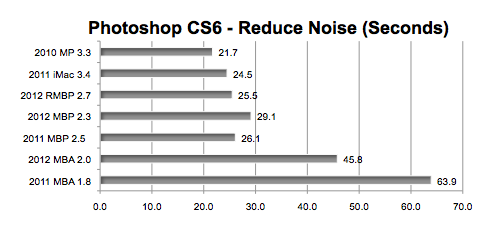SHOOTOUT: Adobe Photoshop CS6
on various 2012 and 2011 Apple Laptops
Originally posted Friday, June 22nd, 2012, by rob-ART morgan, mad scientist
July 30th, 2012, added 2011 iMac 3.4GHz
Continuing in our series of real world tests, we wanted to see how well the 'mid 2012' Retina MacBook Pro handles Adobe Photoshop CS6 compared to other recent Apple laptops and one popular Apple tower. As some of you already know, Adobe software is increasingly handing off certain functions to the graphics processing unit (GPU) because it is faster than using the central processing unit (CPU). So we've chosen a mix of tests that show you the performance advantage (or disadvantage) of a given CPU and GPU combo.
GRAPH LEGEND
2010 MP 3.3 = 'mid 2010' Mac Pro 6-Core 3.33GHz Hex-Core Westmere with 24GB of RAM and Radeon HD 5870 GPU (1GB of video memory) + OCZ Vertex 2 3Gb/s SSD (boot drive)
2011 iMac 3.4 = 'mid 2011' iMac 3.4GHz Quad-Core i7 with 16GB of RAM and Radeon HD 6970M GPU (2GB video memory) + Factory Seagate HDD (boot drive)
2012 RMBP 2.7 = 'mid 2012' Retina MacBook Pro 2.7GHz Quad-Core i7 with 16GB of RAM and GeForce GT 650M GPU (1GB video memory) + Factory 6Gb/s SSD (boot drive)
2012 MBP 2.3 = 'mid 2012' MacBook Pro 2.3GHz Quad-Core i7 with 16GB of RAM and GeForce GT 650M GPU (512MB video memory) + TransIntl SwiftData 6Gb/s SSD (boot drive)
2011 MBP 2.5 = 'late 2011' MacBook Pro 2.5GHz Quad-Core i7 with 16GB of RAM and Radeon HD 6770M GPU (1GB video memory) + OWC Mercury Extreme Pro 6Gb/s SSD (boot drive)
2012 MBA 2.0 = 'mid 2012' MacBook Air 2.0GHz Dual-Core i7 with 8GB of RAM and Intel HD 4000 GPU + Factory 6Gb/s Flash Storage.
2011 MBA 1.8 = 'mid 2011' MacBook Air 1.8GHz Dual-Core i7 with 4GB of RAM and Intel HD 3000 GPU + Factory 3Gb/s Flash Storage.
REDUCE NOISE
This is primarily a CPU test that uses multiple CPU cores to reduce noise in a 169 MB (6096x4558) test image. Time is in seconds. SHORTEST bar means fastest.

BF ACTIONS
This action file generates a 1GB image. Then applies various filters and functions including Duplicate Layer, Smart Sharpen, Gaussian Blur, Rotate, Unsharp Mask. Time is in seconds. SHORTEST bar means fastest.
IRIS BLUR
We defined a small area in the middle of the 6096x4558 image and rendered this effect using default settings except for defining the Iris Blur as 500 pixels. This filter uses OpenCL GPU acceleration if it is supported by the GPU. Time is in seconds. SHORTEST bar means fastest.
LIQUIFY
We distorted the 6096x4558 image with 8 strokes of our 600 pixel brush size with 100% pressure. GPU acceleration was enabled. The times below are in seconds. SHORTER bar is faster.
ANALYSIS and INSIGHTS
(UPDATED June 28) In our original posting, the Retina MacBook Pro exhibited a slow iris Blur render time of 185 seconds because we could not enable OpenCL in Photoshop preferences. Yet the low-end 2012 MacBook Pro with the same GPU did allow us to enable OpenCL.We reported this contradiction to both Adobe and NVIDIA. Meanwhile, two Retina MacBook Pro owners reported that they were able to check "Use OpenCL" in Preferences. (Sound of me scratching my head.)
One engineering colleague suggested connecting the Retina MBP to an external Thunderbolt display as a way of "jostling" the GPU and forcing the use of the discreet GeForce GT 650M. When that didn't change things, we cloned the internal storage to an external Thunderbolt storage unit in anticipation of zapping and reinstalling OS X Lion on the internal flash storage. We booted from the external drive to confirm the success of the cloning process. And, "just for fun," we launched Photoshop CS6. Presto Chango! Photoshop Preferences now allowed us to enable OpenCL. Then we booted using the original Retina MBP internal flash storage and launched Photoshop CS6. "Use OpenCL" was no longer grayed out in Preferences. We were able to check to box to enable OpenCL support. Iris Blur now only took 25 seconds to render.
Whether it was the external display or the Restart, or both, or "ooga booga," we are just glad our pricey Retina MacBook Pro now offers the same OpenCL support in Photoshop that the cheaper entry level 2012 MacBook Pro and late 2011 MacBook Pro both offer.
BOTTOM LINE: The MacBook Pros performed well and, with enough RAM, could replace a desktop as your main Photoshop workstation. On the other hand, the 'mid 2012' MacBook Air, though improved with 8G of RAM, faster CPU, faster GPU, and faster SSD, lags significantly behind the Mac Pro and MacBook Pro as a Photoshop workstation.
RELATED ARTICLES
Lloyd Chambers posted a page comparing the 'mid 2012' Retina MacBook Pro to other Macs running his Photoshop CS6 benchmarks.
Feedback or comments? Email
Also, you can follow me on Twitter @barefeats
WHERE TO BUY ADOBE PHOTOSHOP CS6 (or other Adobe products)
Order directly from Adobe USA. Don't live in USA? Try these links to Adobe France, Adobe Germany, Adobe Sweden, or Adobe UK. (Clicking our links helps us earn a commission.)
WHERE TO BUY APPLE PRODUCTS
Readers in the USA can help us earn a commission by ordering products using this link: